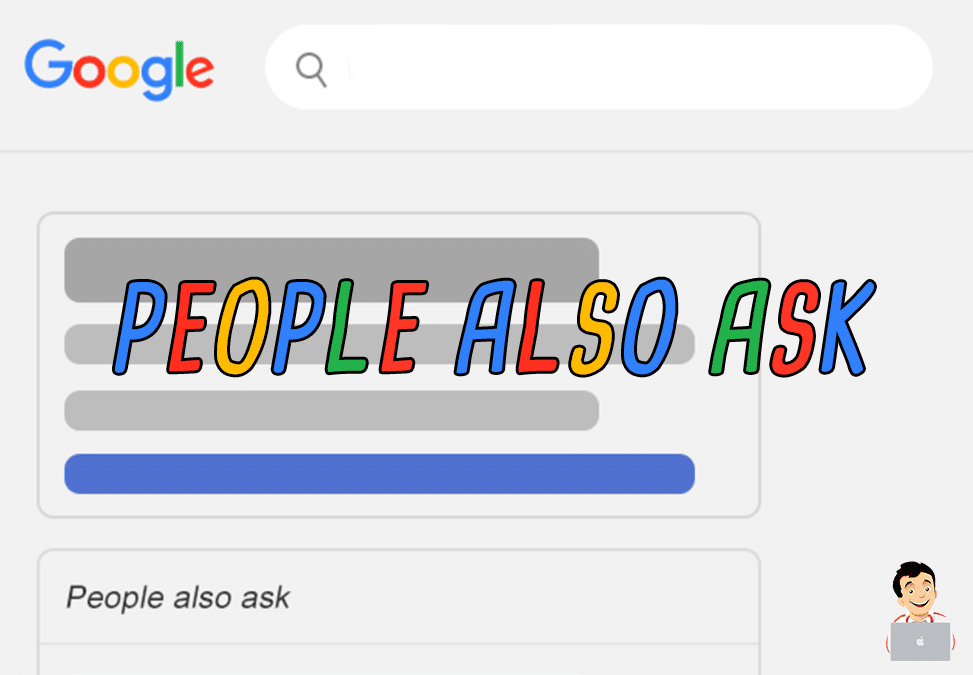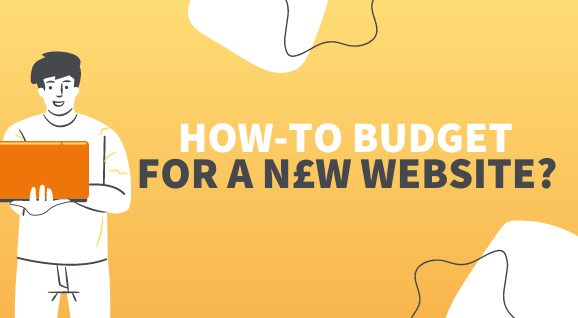What Is People Also Ask Questions (PAA) and How to Use It for SEO
When you search for something on Google, have you noticed that neat little box with related questions that pop up? That’s called the People Also Ask Questions (PAA) box, and it’s a goldmine for both searchers and content creators.
Think about it: you type in a question, and suddenly you’re greeted with even more questions related to your initial search. It’s like Google saying, “Hey, if you’re curious about this, you’ll probably want to know these too.” For anyone trying to grow their website or boost their content strategy, these boxes are pure magic. They show exactly what your target audience is searching for, offering keyword opportunities to answer queries and rank better.
Understanding how search engines pull data into the PAA box can help you write content that gives users exactly what they’re looking for—specific answers that match their search intent. And the bonus? When your content aligns with these questions, you don’t just provide value—you also position yourself to capture prime real estate in Google’s search results.
In this guide, we’ll break down everything you need to know about creating blog posts that answer PAA questions, helping you get noticed, drive more traffic, and reach your audience right where they’re searching.
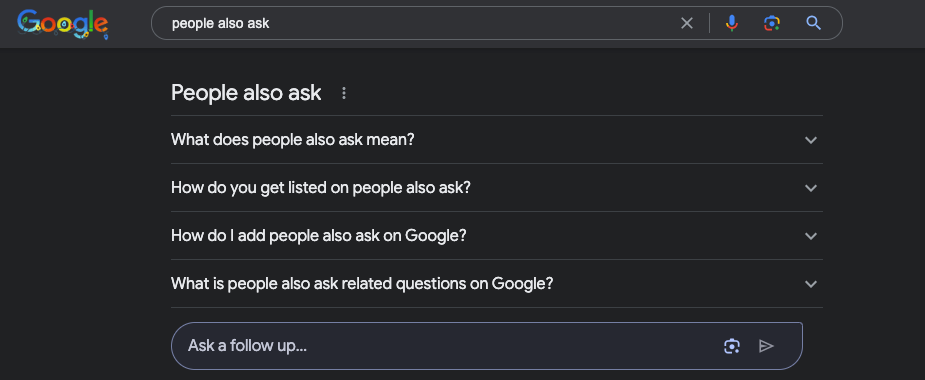
Ready to turn those PAA boxes into opportunities? Let’s dive in.
Understanding “People Also Ask” Questions (PAA)
The People Also Ask (PAA) box is one of the most dynamic features in Google’s search results, designed to address search intent quickly and efficiently. It typically appears in response to an initial search query and contains questions related to what the user originally typed.
Here’s how it works:
- When users click on a question in the PAA box, it expands to show a short answer pulled directly from a webpage, often including a link to the source.
- Clicking on one question often generates additional questions, reflecting related topics users might explore as part of their search behavior.
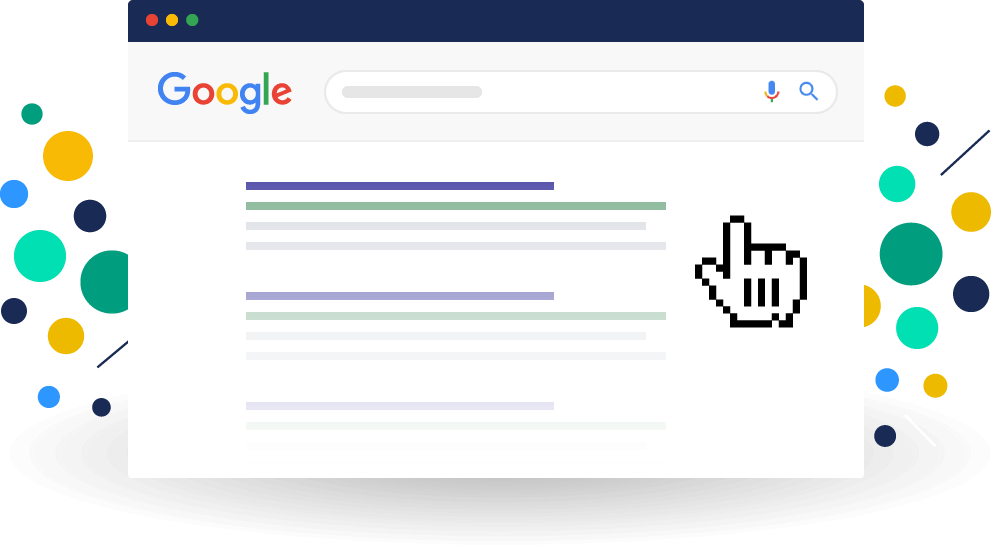
Why Does Google Use the PAA Box?
Google creates the PAA feature to better meet user needs by offering quick, relevant information without forcing users to scroll endlessly. It’s part of their focus on understanding user search intent and providing specific answers to common queries. For example:
- Someone searching for “how to write a blog post” might see a PAA box with related questions like:
- “What makes a good blog post?”
- “How do I start writing a blog?”
- “What are some content creation tips?”
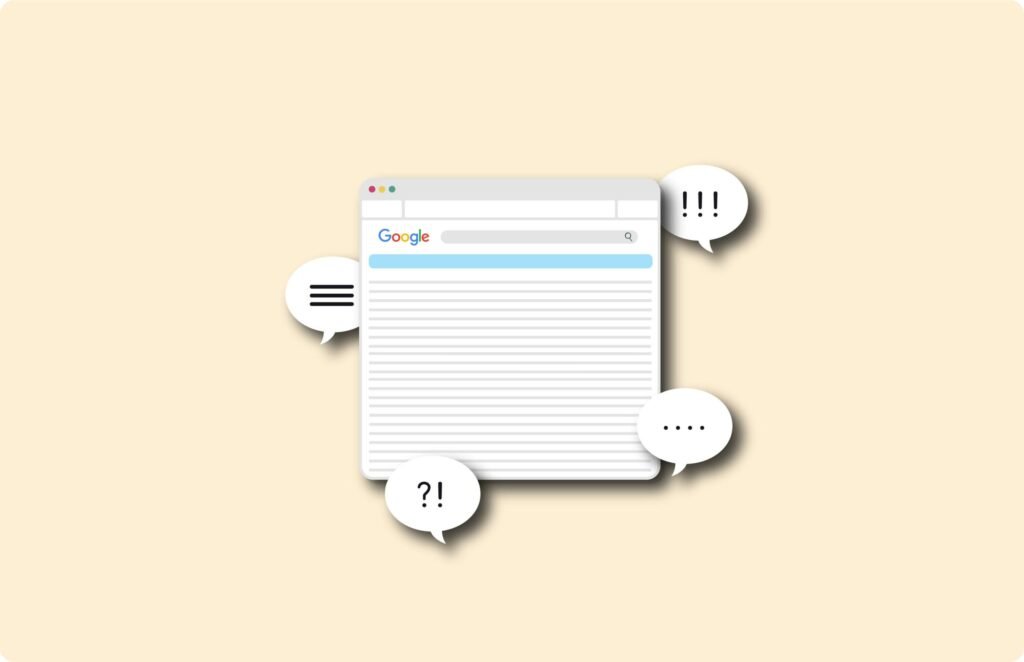
By addressing these queries, Google improves the search experience while giving website owners an opportunity to target PAA questions that resonate with their target audience.
Why Does PAA Matter for Content Creators?
The PAA box isn’t just a helpful tool for users—it’s also a huge opportunity for website owners and bloggers. By understanding which PAA questions appear for your primary keyword, you can:
- Craft content that aligns with real search queries.
- Increase visibility by landing in the PAA section.
- Target valuable keyword opportunities and gain more traffic.

If you’re not optimizing for the PAA box, you’re missing out on a key chance to deliver specific answers to questions your audience is already asking.
Why “People Also Ask” Matters for SEO and Content Strategy
The People Also Ask (PAA) box isn’t just a handy feature for users; it’s a critical part of any modern content strategy. By targeting PAA questions, content creators and website owners can tap into the exact queries users are searching for, ultimately driving more traffic and improving rankings in Google’s search results.
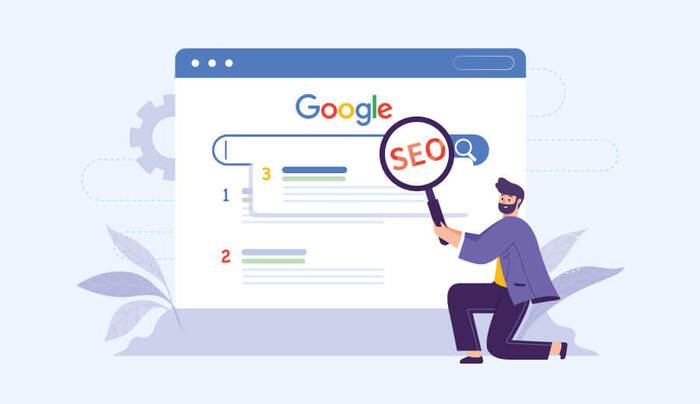
PAA Drives Visibility and Traffic
Appearing in the PAA box means landing a prime spot on the search results page. It’s like having your content featured on Google’s front porch, where users can find it instantly. Here’s why this matters:
- The PAA box often appears above the traditional search results, making it a highly visible spot to earn clicks.
- By providing specific answers to questions users care about, your content becomes a go-to resource for both Google and your target audience.
- Sites featured in PAA results often experience increased organic traffic, which means more eyeballs on your content and potential customers discovering your site.
Helps Capture Featured Snippets
Many PAA answers are also potential candidates for featured snippets, which are those direct, structured answers that sit right at the top of Google’s search results. By formatting your content with specific answers to common search queries, you increase your chances of being highlighted.
For example:
- PAA Question: What is search intent?
- Your Answer: Search intent refers to the reason behind a user’s search query. It helps determine whether the user wants to learn something, make a purchase, or find a specific webpage.
This approach delivers a clear, short answer that aligns perfectly with what Google looks for in the PAA box and featured snippets.
Unlocks New Keyword Opportunities
One of the biggest advantages of PAA is its ability to reveal keyword opportunities. By analyzing PAA data, you can:
- Discover related questions and new search terms you might not have considered.
- Find long-tail keywords that align with search intent and are easier to rank for.
- Identify gaps in existing content and create posts that address user pain points directly.
By incorporating PAA questions into your content strategy, you’re not just guessing what your audience wants—you’re using actual search data to guide your content creation process.
Why It Matters for Your Content Strategy
Targeting PAA questions allows you to:
- Align content with search behavior and user search intent.
- Increase chances of appearing in the PAA section and Google’s featured snippets.
- Drive more traffic by addressing queries that your target audience is actively searching for.
Simply put, optimizing for People Also Ask is a strategic way to boost your visibility, uncover valuable keyword opportunities, and position yourself as an authority in your niche.
How to Find the Right People Also Ask (PAA) Questions
To write blog posts that answer People Also Ask (PAA) questions effectively, you need to identify the right questions that align with your audience’s search intent. This requires strategic keyword research and understanding how Google generates these queries based on user behavior. Here’s a step-by-step approach to finding the best PAA opportunities for your content.
1. Start with Google Search
The simplest and most effective place to find PAA questions is right on Google. Follow these steps:
- Enter a primary keyword or search query related to your topic.
- Scroll down to the PAA box and note the questions that appear.
- Click on a few PAA questions to trigger additional questions—this reveals related queries and helps you understand user search behavior.
For example, searching “how to write a blog post” might show PAA questions like:
- “What are the steps to write a blog?”
- “How do I make my blog rank on Google?”
- “What is the ideal blog length?”
These questions offer a goldmine of keyword opportunities for your blog content.
2. Use Keyword Research Tools
Advanced tools like SEMrush Keyword Magic Tool, Ahrefs, and AnswerThePublic can help you analyze PAA data more efficiently. Here’s how:
- Input your primary keyword to discover trending keywords and PAA-related queries.
- Identify questions with high search volume and align them with user search intent.
- Focus on long-tail keywords—these often match the phrasing of PAA questions and are easier to rank for.
Example Workflow with SEMrush:
- Search for “content strategy.”
- Look under Questions in the Keyword Magic Tool to find queries like:
- “What is a content strategy example?”
- “How do I plan content strategy?”
- These align perfectly with PAA opportunities.
3. Analyze Competitor Content
To uncover relevant PAA questions, analyze the top-ranking pages in Google’s search results for your target keywords. Here’s what to do:
- Check which PAA questions your competitors rank for.
- Identify gaps in their content where you can provide specific answers or better helpful content.
- Use these insights to create content that directly answers user queries while addressing any overlooked search terms.
This method allows you to capture missed opportunities and position yourself ahead of competitors.
4. Review PAA Data Regularly
The PAA box is dynamic—it changes based on evolving user search behavior and search history. To keep up:
- Monitor PAA results for your focus topics regularly.
- Update your content to include new keywords and questions related to your niche.
- Use tools like Google Trends to identify trending keywords and emerging related queries.
5. Explore Related Queries and Search Terms
When you identify a core question, expand your research to uncover related queries and additional search terms:
- Use the “Related Searches” section at the bottom of Google’s results page.
- Combine PAA questions with similar search queries to create topic clusters that drive even more traffic.
For example:
- Core query: “What is search intent?”
- Related PAA questions:
- “Why is search intent important?”
- “How do I determine search intent for a keyword?”
Pro Tip: Align Questions with Your Target Audience
Always focus on questions that resonate with your target audience. By answering real problems or pain points, you provide valuable information and enhance your chances of ranking higher in the PAA section.
Structuring Blog Content to Answer PAA Questions
Now that you’ve identified the right PAA questions through keyword research and analyzed user search intent, it’s time to structure your blog content in a way that satisfies both Google and your target audience. The goal here is to provide specific answers in a clear, optimized format that increases your chances of appearing in the PAA box and capturing featured snippets.
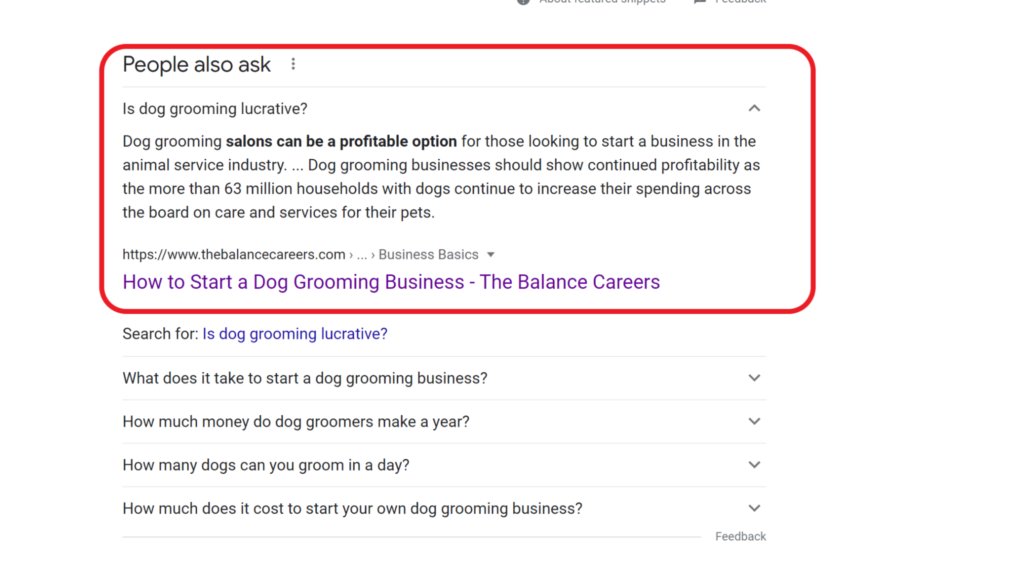
Here’s a step-by-step method for structuring your content:
1. Start with the Question
Use the exact PAA question as a headline or subheading in your blog post. This directly matches what users are searching for and aligns your content with the query.
- Example: If the PAA question is, “What is search intent?”, make it an H2 tag like:
- “What is Search Intent and Why Does It Matter?”
This approach helps Google understand that your content provides a specific answer to the user’s search query.
2. Provide a Short, Clear Answer First
Google favors content that delivers short answers upfront. Begin each section with a concise, specific answer (1-3 sentences) that addresses the question directly.
- Example:
- “Search intent refers to the purpose behind a user’s search query. It determines whether the user wants to learn, find, or purchase something.”
By leading with a quick answer, you increase your chances of getting featured in the PAA box or featured snippets.
3. Expand with Valuable, Helpful Content
After the short answer, expand the section with additional details, valuable information, and examples to satisfy the reader’s curiosity and improve engagement. Consider including:
- Definitions and explanations that clarify key terms.
- Relevant data or statistics to back up your points.
- Lists, bullet points, and examples to improve readability.
This approach aligns with Google’s preference for helpful content that directly addresses user search behavior.
4. Use Proper Formatting for Readability
Google loves well-structured, skimmable content that enhances the user experience. Use:
- Headings and Subheadings (H2s and H3s) to organize questions related to the topic.
- Bullet points, lists, or tables for clarity when answering complex queries.
- Bolded key terms, such as PAA questions, search terms, or keyword opportunities, to emphasize important concepts.
Example Format:
- H2: What is search intent?
- Short answer (1-2 sentences).
- Expanded content: Explanation, examples, and supporting data.
- H3: Why is search intent important?
- Address the deeper context and connect to related search queries.
5. Align with Featured Snippet Formats
The PAA box often pulls from content structured like featured snippets. To optimize your content:
- Answer PAA questions in formats such as:
- Paragraphs (concise explanations).
- Lists (steps or tips).
- Tables (comparisons or data).
- Use structured FAQ sections to answer multiple PAA opportunities within a single post.
This method not only satisfies search intent but also increases your chances of being featured in Google’s PAA section.
6. Add Internal Links and Related Queries
To provide a seamless user experience, link to other relevant content on your website. This helps:
- Keep users on your site longer.
- Guide readers toward more in-depth answers for related queries.
- Strengthen topic clusters by connecting PAA questions to other pieces of content.
Example: If answering “How do I optimize for search intent?”, link to a related post like “Keyword Research Tips for Matching Search Intent.”
7. Include Visuals and Descriptive File Names
Enhance your blog post with visuals like diagrams, infographics, or screenshots to explain complex answers. Ensure all visuals use descriptive file names and alt text that include target keywords and PAA questions.
For example:
- File name: search-intent-examples.png.
- Alt text: “Examples of search intent for blog post optimization.”
Why This Structure Works
By structuring your blog post this way, you’re:
- Aligning content with PAA data and search queries.
- Providing quick, specific answers that satisfy search intent.
- Optimizing your content for Google’s PAA box and featured snippets.
- Improving user experience through well-formatted, helpful content.
When you deliver answers in a structured and engaging way, you maximize your chances of ranking in Google’s search results while providing immense value to your target audience.
Optimizing for PAA and Search Engines
Writing blog content that answers People Also Ask (PAA) questions isn’t just about providing great answers—it’s also about optimizing your content so that search engines like Google can understand and prioritize it in the PAA box and featured snippets. Here’s how you can fine-tune your content for better rankings and more traffic.

1. Use Schema Markup to Stand Out
FAQ schema and Q&A schema help Google understand your content better, increasing the likelihood of it appearing in the PAA section and even featured snippets.
- Add structured data markup to highlight questions and their specific answers in your blog post.
- Tools like Google’s Structured Data Testing Tool can help validate your schema.
Pro Tip: Implementing FAQ schema works best when you include several PAA questions with quick answers in your post.
2. Optimize for Target Keywords and Search Intent
Your content must naturally incorporate target keywords and align with user search intent. Here’s how:
- Place PAA questions and your primary keyword in headings (H2s and H3s).
- Include short answers directly after each heading to satisfy immediate user queries.
- Expand on the content by addressing related search terms and questions related to the topic.
For example, if the PAA question is “How do I find trending keywords?”:
- Short Answer: “You can find trending keywords using tools like Google Trends, SEMrush’s Keyword Magic Tool, or AnswerThePublic.”
- Expanded Section: Add tools, examples, and actionable tips.
3. Track and Analyze PAA Data
Monitoring PAA data helps you improve your content and adapt to evolving search behavior. Follow these steps:
- Use tools like SEMrush, Ahrefs, or Google Search Console to analyze PAA opportunities for your content.
- Track which PAA questions drive traffic to your site and identify new related queries.
- Update your content regularly to answer fresh PAA questions or incorporate trending keywords.
Regular updates signal to Google that your content remains helpful content and relevant, increasing your chances of staying visible in the PAA box.
4. Focus on Quick, Specific Answers
The PAA box favors specific answers that are concise and to the point. To optimize:
- Lead with a short answer (1-3 sentences) that directly answers the query.
- Follow up with expanded, valuable information to engage readers who want more details.
- Use bullet points, numbered steps, or tables where appropriate—Google loves clear, organized answers.
Example Format:
- H2: How do you optimize for the PAA box?
- Short Answer: “Provide clear, concise answers to PAA questions, use schema markup, and structure content to match search intent.”
- Expanded Content: List the steps, tools, and best practices.
5. Improve User Experience with Formatting and Visuals
Google rewards content that improves user experience, which means you need to make your answers easy to read and engaging.
- Use descriptive file names and alt text for visuals.
- Include images, charts, and videos to clarify complex answers.
- Format your content with headings, subheadings, and bullet points to increase readability.
For example:
- File Name: paa-box-example.png
- Alt Text: “Example of a People Also Ask box in Google search results.”
6. Test and Refine Your Content Strategy
Optimizing for PAA opportunities isn’t a one-and-done deal. It requires ongoing testing and updates:
- Track your performance in Google’s search results to see which PAA questions you rank for.
- Identify areas to improve by analyzing metrics like search volume and organic traffic.
- Add new sections to answer additional questions that appear in the PAA box over time.
By consistently refining your content based on PAA data, you can uncover new keywords, improve visibility, and attract more of your target audience.
Why Optimization Matters
When you optimize for PAA questions:
- You align your content with user search intent and search behavior.
- You increase your chances of appearing in the PAA section and featured snippets.
- You deliver valuable information to your audience while driving more traffic to your website.
The result? Higher rankings, improved visibility, and a content strategy that works smarter, not harder.
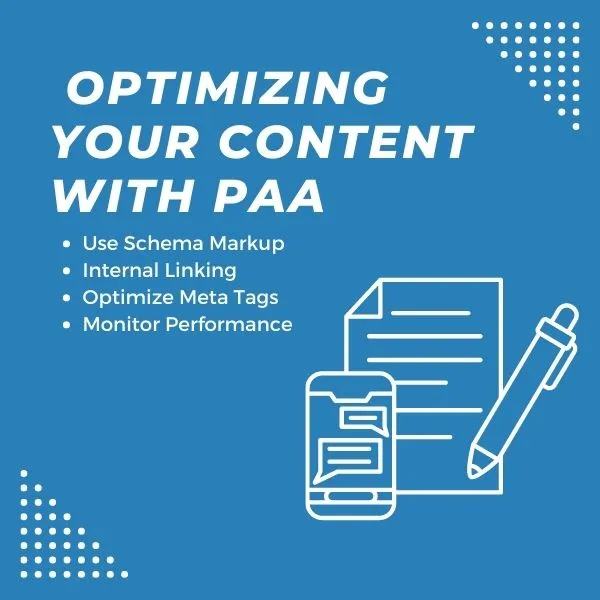
Tracking Success and Expanding Content Opportunities
Once your blog content is live and optimized for People Also Ask (PAA) questions, the next step is to measure its success and use the insights to uncover new content opportunities. Regular monitoring and updates ensure your content stays relevant, ranks higher in Google’s search results, and continues to drive organic traffic.

1. Track PAA Performance Using Analytics Tools
Monitoring your content’s performance helps you identify which PAA questions are driving more traffic and which need improvement. Use tools like:
- Google Search Console: Track which queries your content ranks for, including any appearances in the PAA box.
- SEMrush or Ahrefs: Analyze PAA opportunities, discover new related queries, and measure search volume for key terms.
What to Monitor:
- Number of clicks and impressions from PAA results.
- Which specific answers are driving the most traffic.
- Rankings for target keywords and trending keywords.
By studying this data, you can refine your content strategy and identify new keyword opportunities.
2. Update and Optimize Existing Content
The PAA box evolves over time based on changes in user search behavior and search intent. Keep your content fresh and competitive with regular updates:
- Add new PAA questions that have emerged since you first published your blog post.
- Include short answers and expand with valuable information to address additional queries.
- Optimize for featured snippets by improving clarity, formatting, and relevance.
Pro Tip: Use Google Search to check for new questions related to your topic. Expand your content to include answers to these emerging queries.
3. Expand Content with Related Queries
Every PAA question opens the door to additional content opportunities. Use related search terms and PAA data to create:
- New blog posts targeting deeper, niche-specific topics.
- FAQ sections within existing posts to answer multiple questions efficiently.
- Content clusters that link related topics together, improving your site’s overall authority.
For example:
- If you answered “What is search intent?” in your main blog post, you could create new posts like:
- “How to Identify Search Intent in Keyword Research.”
- “Search Intent Examples for Different Content Strategies.”
4. Monitor Competitor Content for PAA Insights
Competitors can reveal untapped PAA opportunities. Analyze top-ranking pages to see which PAA questions they answer and identify content gaps:
- Are there questions related to your topic that competitors missed?
- Could you provide specific answers with more depth, visuals, or valuable information?
This approach helps you stay ahead by offering superior, user-focused content.
5. Align with Search Trends and New Keywords
Stay updated with trending keywords and user interests to capture emerging queries:
- Use tools like Google Trends and SEMrush Keyword Magic Tool to find rising search terms.
- Target seasonal trends or newly relevant topics to position yourself as an authority in your niche.
- Include descriptive file names and alt text for new visuals to further optimize content for Google’s search results.
Example:
- If “AI tools for blogging” becomes a trending term, you could create a post answering:
- “How do AI tools improve content strategy?”
- “What are the best AI tools for writing blog posts?”
6. Measure Long-Term Success and Adapt
Success with the PAA box is a long-term game. Regularly measure performance and adapt your strategy based on the data:
- Review increases in organic traffic and user engagement.
- Adjust content to reflect changes in PAA questions and user search behavior.
- Identify new keywords or related queries to continue expanding your content.
By tracking and adapting, you ensure your content remains a valuable resource for your target audience while maximizing opportunities to rank in the PAA section.
Mastering the People Also Ask (PAA) box is about answering real user questions with clarity, value, and precision. By continually tracking performance, updating your content, and expanding into new opportunities, you’ll keep driving more traffic, aligning with search intent, and staying ahead in Google’s search results.
The key is to stay consistent, leverage PAA data, and always focus on delivering specific answers that satisfy your audience’s needs.
Conclusion: Turning People Also Ask (PAA) into a Content Goldmine
The People Also Ask (PAA) box is more than just a handy feature in Google’s search results—it’s a treasure trove of opportunities for content creators, website owners, and businesses to boost visibility and drive more traffic. By understanding user search behavior and targeting PAA questions, you position yourself to meet user search intent while enhancing your SEO game.
Here’s a quick recap of the strategy:
- Identify Relevant PAA Questions: Use tools like Google Search, Keyword Magic Tool, and PAA data analysis to find questions related to your niche.
- Structure Your Content for Success: Provide short answers up front, expand with valuable information, and format for readability to align with PAA opportunities and featured snippets.
- Optimize for Search Engines: Use schema markup, descriptive file names, and proper keyword placement to improve your chances of ranking in the PAA section.
- Track and Expand: Continuously monitor performance, analyze PAA data, and adapt your content to address emerging search terms and trends.
When done right, answering PAA questions is more than just a content strategy—it’s a way to connect with your target audience, address their queries, and position yourself as the go-to source for specific answers in your field.
So, the next time you see a PAA box appear in Google, don’t just scroll past it—see it for what it really is: a roadmap to smarter content creation, better rankings, and real results. Start answering the questions your audience is asking, and let your content shine. 🚀
Disclosure: Our blog contains affiliate links to products. We may receive a commission for purchases made through these links. However, this does not impact our reviews and comparisons. We try our best to keep things fair and balanced, in order to help you make the best choice for you.

